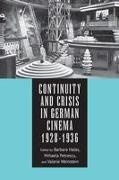Read more
List of contents
List of Illustrations
Acknowledgments
Introduction
"Timid Heresies": Werner Hochbaum's
Razzia in St. Pauli (1932) - Christian Rogowski
Film as Pedagogy in Late Weimar and Early Nazi Cinema: The Role of the Street in Mobilizing the Spectator - Bastian Heinsohn
"A Fairytale for Grown-ups": Financial and Cinematic Crises in
Die Koffer des Herrn O.F. (1931) - Paul Flaig
"Denn Gold ist Glück und Fluch dieser Welt": Examining the Trope of "Gold" in
Gold (1934) and
Der Kaiser von Kalifornien (1936) - Owen Lyons
Degenerate Disease and the Doctors of Death: Racial Hygiene Film as Propaganda in Weimar and Early Nazi Germany - Barbara Hales
"White Jews" and Dark Continents: Capitalist Critique and Its Racial Undercurrents in Detlef Sierck's
April! April! (1935) - Valerie Weinstein
The
Zigeunerdrama Reloaded: Leni Riefenstahl's Fantasy Gypsies and Sacrificial Others - Anjeana Hans
Regaining Mobility: The Aviator in Weimar Mountain Films - Wilfried Wilms
Brigitte Helm and Germany's Star System in the 1920s and 1930s - Mihaela Petrescu
Foreign Attractions: Czech Stars and Ethnic Masquerade - Kevin B. Johnson
Objects in Motion: Hans Richter's
Vormittagsspuk (1928) and the Crisis of Avant-Garde Film - Brook Henkel
Seeing Crisis in Harry Piel's
Ein Unsichtbarer geht durch die Stadt (1933) - Kalani Michell
Playing the European Market: Marcel L'Herbier's
L'Argent (1928), Ufa, and German-French Film Relations - Margrit Frölich
A Serious Man? Ernst Lubitsch's Anti-War Film
The Man I Killed (a.k.a.
Broken Lullaby, USA 1932) - Richard W. McCormick
Selected Bibliography
Notes on the Contributors
Index
About the author
Barbara Hales, Mihaela Petrescu, Valerie Weinstein

